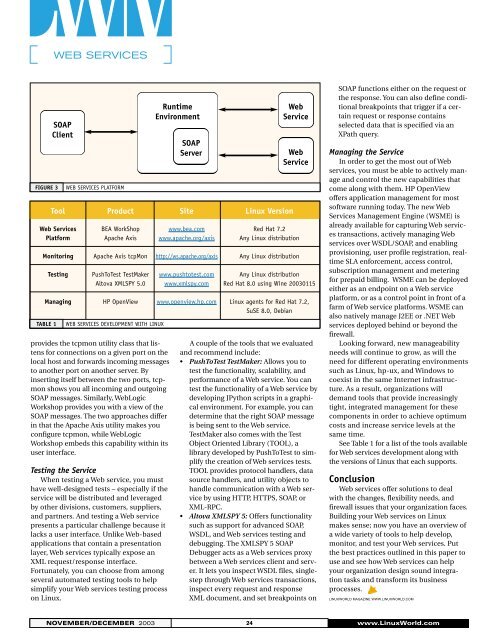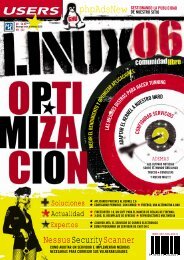Linux - Index of
Linux - Index of
Linux - Index of
You also want an ePaper? Increase the reach of your titles
YUMPU automatically turns print PDFs into web optimized ePapers that Google loves.
FIGURE 3<br />
WEB SERVICES<br />
WEB SERVICES PLATFORM<br />
Tool Product Site <strong>Linux</strong> Version<br />
Web Services BEA WorkShop www.bea.com Red Hat 7.2<br />
Platform Apache Axis www.apache.org/axis Any <strong>Linux</strong> distribution<br />
Monitoring Apache Axis tcpMon http://ws.apache.org/axis Any <strong>Linux</strong> distribution<br />
Testing PushToTest TestMaker www.pushtotest.com Any <strong>Linux</strong> distribution<br />
Altova XMLSPY 5.0 www.xmlspy.com Red Hat 8.0 using Wine 20030115<br />
Managing HP OpenView www.openview.hp.com <strong>Linux</strong> agents for Red Hat 7.2,<br />
SuSE 8.0, Debian<br />
TABLE 1<br />
SOAP<br />
Client<br />
WEB SERVICES DEVELOPMENT WITH LINUX<br />
provides the tcpmon utility class that listens<br />
for connections on a given port on the<br />
local host and forwards incoming messages<br />
to another port on another server. By<br />
inserting itself between the two ports, tcpmon<br />
shows you all incoming and outgoing<br />
SOAP messages. Similarly, WebLogic<br />
Workshop provides you with a view <strong>of</strong> the<br />
SOAP messages. The two approaches differ<br />
in that the Apache Axis utility makes you<br />
configure tcpmon, while WebLogic<br />
Workshop embeds this capability within its<br />
user interface.<br />
Testing the Service<br />
When testing a Web service, you must<br />
have well-designed tests – especially if the<br />
service will be distributed and leveraged<br />
by other divisions, customers, suppliers,<br />
and partners. And testing a Web service<br />
presents a particular challenge because it<br />
lacks a user interface. Unlike Web-based<br />
applications that contain a presentation<br />
layer, Web services typically expose an<br />
XML request/response interface.<br />
Fortunately, you can choose from among<br />
several automated testing tools to help<br />
simplify your Web services testing process<br />
on <strong>Linux</strong>.<br />
Runtime<br />
Environment<br />
SOAP<br />
Server<br />
Web<br />
Service<br />
Web<br />
Service<br />
A couple <strong>of</strong> the tools that we evaluated<br />
and recommend include:<br />
• PushToTest TestMaker: Allows you to<br />
test the functionality, scalability, and<br />
performance <strong>of</strong> a Web service. You can<br />
test the functionality <strong>of</strong> a Web service by<br />
developing JPython scripts in a graphical<br />
environment. For example, you can<br />
determine that the right SOAP message<br />
is being sent to the Web service.<br />
TestMaker also comes with the Test<br />
Object Oriented Library (TOOL), a<br />
library developed by PushToTest to simplify<br />
the creation <strong>of</strong> Web services tests.<br />
TOOL provides protocol handlers, data<br />
source handlers, and utility objects to<br />
handle communication with a Web service<br />
by using HTTP, HTTPS, SOAP, or<br />
XML-RPC.<br />
• Altova XMLSPY 5: Offers functionality<br />
such as support for advanced SOAP,<br />
WSDL, and Web services testing and<br />
debugging. The XMLSPY 5 SOAP<br />
Debugger acts as a Web services proxy<br />
between a Web services client and server.<br />
It lets you inspect WSDL files, singlestep<br />
through Web services transactions,<br />
inspect every request and response<br />
XML document, and set breakpoints on<br />
SOAP functions either on the request or<br />
the response. You can also define conditional<br />
breakpoints that trigger if a certain<br />
request or response contains<br />
selected data that is specified via an<br />
XPath query.<br />
Managing the Service<br />
In order to get the most out <strong>of</strong> Web<br />
services, you must be able to actively manage<br />
and control the new capabilities that<br />
come along with them. HP OpenView<br />
<strong>of</strong>fers application management for most<br />
s<strong>of</strong>tware running today. The new Web<br />
Services Management Engine (WSME) is<br />
already available for capturing Web services<br />
transactions, actively managing Web<br />
services over WSDL/SOAP, and enabling<br />
provisioning, user pr<strong>of</strong>ile registration, realtime<br />
SLA enforcement, access control,<br />
subscription management and metering<br />
for prepaid billing. WSME can be deployed<br />
either as an endpoint on a Web service<br />
platform, or as a control point in front <strong>of</strong> a<br />
farm <strong>of</strong> Web service platforms. WSME can<br />
also natively manage J2EE or .NET Web<br />
services deployed behind or beyond the<br />
firewall.<br />
Looking forward, new manageability<br />
needs will continue to grow, as will the<br />
need for different operating environments<br />
such as <strong>Linux</strong>, hp-ux, and Windows to<br />
coexist in the same Internet infrastructure.<br />
As a result, organizations will<br />
demand tools that provide increasingly<br />
tight, integrated management for these<br />
components in order to achieve optimum<br />
costs and increase service levels at the<br />
same time.<br />
See Table 1 for a list <strong>of</strong> the tools available<br />
for Web services development along with<br />
the versions <strong>of</strong> <strong>Linux</strong> that each supports.<br />
Conclusion<br />
Web services <strong>of</strong>fer solutions to deal<br />
with the changes, flexibility needs, and<br />
firewall issues that your organization faces.<br />
Building your Web services on <strong>Linux</strong><br />
makes sense; now you have an overview <strong>of</strong><br />
a wide variety <strong>of</strong> tools to help develop,<br />
monitor, and test your Web services. Put<br />
the best practices outlined in this paper to<br />
use and see how Web services can help<br />
your organization design sound integration<br />
tasks and transform its business<br />
processes.<br />
LINUXWORLD MAGAZINE WWW.LINUXWORLD.COM<br />
NOVEMBER/DECEMBER 2003 24 www.<strong>Linux</strong>World.com




